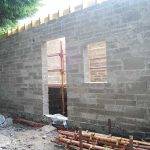Percolation test
If you cannot connect to the mains, don’t despair, there are still many options available. An off mains system is an individual solution that treats waste to a quality that can be discharged either into your land or, in NI, to a nearby watercourse.
The key to finding the right system for your plot is a percolation test. You need to establish the porosity of your soil to prevent an inadequate system being installed, resulting in part treated waste in your soil or contamination of a nearby lake. You will need documentation signed by the Architect or Engineer for your system to certify it has been installed correctly in compliance with Building Regulations in NI. For ROI builders, the sign off must be in compliance with the planning conditions stipulated by the Local Authority or County Council. If faults arise in the future, you may need this documentation.
In ROI the percolation test is most commonly carried out by a FÁS trained ’site assessor’; some councils ask that you use someone from their list of pre-approved assessors although this practice has been contested in the past. It’s a good idea to consult with your local council before appointing your site assessor. In NI, anyone can carry out the test.
In the event of an alternative to the main sewer being required, and this will be the case with most rural sites, the percolation test will guide you to the system most compatible with your soil, usually some form of septic tank or on-site treatment system with a percolation or leaching area.
The following is the Environmental Protection Agency (EPA) recommended percolation test:
Day 1: Two test holes are dug in the proposed area. Each hole should be 0.3 x 0.3 x 0.4m deep below the proposed invert level of the distribution pipe (see diagram). The bottom and sides of the hole should be scratched with a knife to remove any compacted soil surfaces to expose natural soil.
Clear water is poured in at 10am and filled to the full height of 0.4m. The water should then be left to percolate. Fill to capacity again at 5pm and then leave overnight.
Day 2: The hole is filled at 10am and the water level allowed to drop to 0.3m. From this point you must time in minutes how long it takes the water to drop from 0.3m to 0.2m. As soon as you have, fill the hole to the 0.3m mark and time again until it reaches the 0.2 mark. Repeat again so that you have three tests in total.
The average time is then calculated from the three readings. The result is divided by four to give the time required for a fall of 25mm. This is the percolation value or t value. The same procedure should then be carried out in the second hole.
Once you have both sets of readings, take the average to give an overall t value. A proposed percolation area with a t value less than one or greater than 50 is deemed to have failed the test. The test also establishes the size and complexity of the percolation area.
Failing the percolation test
You will fail the test if the soil is very porous, e.g. very rocky land, or if the soil isn’t porous enough, e.g. boggy land or with heavy clay. Some remedial work could be done to improve the soil conditions before re-testing. If you still fail after that, you’d either have to discharge very well treated water to a watercourse (only an option in NI) or avail of a ‘zero discharge’ system (constructed wetlands that do not require emptying).
However, know that planning authorities may be wary of granting planning permission for zero discharge systems. While wetlands are discussed in the EPA’s Code of Practice, it discusses it as any other type of treatment system, requiring a discharge to the groundwater. Zero discharge systems are not listed as an alternative in the code, hence the reticence from the planners.
Therefore failing the percolation test is more than likely to mean not being able to install any kind of sewage system and thus not being able to build your house on that land. For those who have passed the test the following options are available.



2 Comments